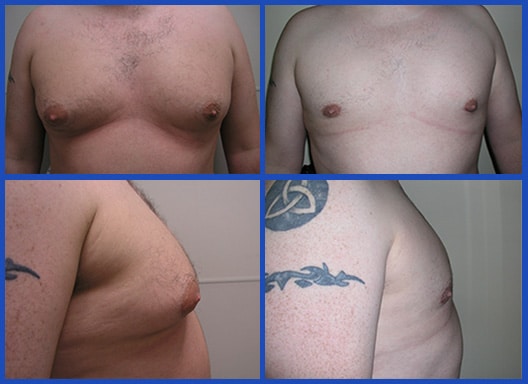Gynecomastia Surgery
For Adults
Dr. Lo customizes a gynecomastia surgery plan for you based on your individual anatomy, body type and severity of your gynecomastia. Dr. Lo uses specific surgical techniques to give you the normal looking masculine chest that you are looking for.
Request A Consultation Before & After
Gynecomastia Surgery For Adults
Many men from age 18 to 75 seek correction and removal of their gynecomastia or man boobs. Despite a healthy and active lifestyle, many men find that their enlarged breasts do not improve or go away and seek options for gynecomastia treatment.
What Is Adult Gynecomastia?
Gynecomastia or man boobs in adults is enlarged breasts in the chest area. The enlarged breasts are usually composed of both breast gland tissue and fat. A normal looking masculine chest should have no or very little breast tissue in the chest area around the nipple/areola.
What Causes Adult Gynecomastia?
Gynecomastia may happen for many reasons. Breast growth is stimulated by hormonal imbalance between testosterone and estrogen levels in your body with higher estrogen levels leading to the development of man boobs or gynecomastia.
The following are common reasons for the development of gynecomastia:
- Puberty: Hormonal imbalance during puberty may lead to development of gynecomastia that persists during later teen and early adult years and never goes away. This is true breast gland tissue in males.
- Obesity: Being overweight during childhood and in teenage years can lead to development of gynecomastia that does not go away even with losing weight or working out. This is called pseudogynecomastia as the enlarged breasts are composed mainly of fatty tissue.
- Drugs: Drugs such as anabolic steroids, anti-reflux meds, digoxin, marijuana, alcohol, etc. may lead to the development of gynecomastia.
- Medical Conditions: Liver disease, testicular atrophy, or tumors etc. may lead to gynecomastia.
- Idiopathic or Unknown: In 25% of cases, we do not know the cause of gynecomastia. This is the most common category.
- Aging: As men age, estrogen levels become higher over declining testosterone levels leading to gynecomastia in older men.
What Surgical Techniques Does Dr. Lo Use To Remove Gynecomastia?
Gynecomastia patients evaluated by Dr. Lo have a combination of breast gland and fat that composes their man boobs. These patients will need both breast gland removal, which is called subcutaneous mastectomy and advanced liposuction to remove the fat, resulting in complete removal of the breast tissue and the best contour in the chest area.
- Subcutaneous mastectomy: The excess breast gland tissue is removed through a small incision around the lower part of the areola/nipple. Puffy nipples are corrected as well giving you a flat normal looking chest.
- Advanced Liposuction: Tumescent technique with ultrasonic and power assisted liposuction is used to contour and sculpt your chest in addition to breast gland removal.
- Skin Removal: In most patients, once the gynecomastia or man boobs is removed, the chest skin will contract, shrink and lie smoothly on the chest. In some patients, it may be necessary to remove excess skin to avoid the possibility of loose skin after gynecomastia surgery.
How Is Pseudogynecomastia Treated?
Since pseudogynecomastia is mainly composed of fat, Dr. Lo will perform advanced liposuction to correct your gynecomastia. Tumescent liposuction, Ultrasonic liposuction and Power assisted liposuction are some of the different liposuction techniques that are used to contour your chest.

Beyond Gynecomastia Correction Surgery
Dr. Lo and his team will guide you through your gynecomastia surgery journey so that you can achieve your goal of a normal looking chest. Many patients combine other cosmetic procedures with gynecomastia surgery. To learn about additional cosmetic procedures please visit Cosmetic Surgery For Men
Contact Us
Schedule A ConsultationLocations
Philadelphia Cosmetic Surgery
301 South 8th Street, Suite 3H,
Philadelphia PA 19106
New Jersey Cosmetic Surgery
990 Route 73 North
Marlton, NJ 08053
Social Media

